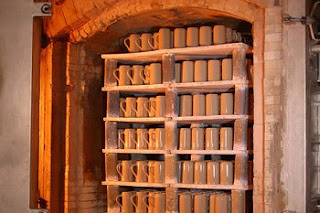The 177th annual Oktoberfest is starting September 18th and will last until October 4th. I have been once to the "real" Oktoberfest and it was fascinating! Definitely not a place for people with OCD ;-)
Here are some things that I thought might be interesting to know:
How is an Oktoberfest beer mug "Stein" made?
Did you know that a complete series of all Oktoberfest steins is worth several thousand euros. Each step, to make the Stein, requires precise manual work, so that each of the limited edition Oktoberfest steins a little work of art.
I researched it a little bit for you and I found out, how the mug is made.
The "Stein" also called "Maß" is made out of clay. The first step is to form the Stein without the handle. Afterwards the handle will be carefully added to the mug.
With a damp sponge, the transitions from the handle and the mug are smoothened out, so that the whole surface is evenly and smooth.
In a large brick furnace, the mugs are then brazed at about 1000 degrees Celsius until they are hard like stone ;-) (get it? Stein = Stone)
After the "Stein" has cooled off, the official Oktoberfest logo is carefully placed by hand on the mug and smoothed out. Now the beer mug looks almost like a proper Oktoberfest beer stein.
With a fine brush, colored edges are painted around the mug. A rotating disc, on which the Oktoberfeststein is placed, mades this procedure a little bit easier to do.
Next up, the "Stein" is put back in the furnace. With this procedure, the Logo is inextricably linked with the mug. Now the collector "Stein" is read! For the "Stein" that is used at the Oktoberfest, a tin lid is added as a last step in this procedure.
A solid, handmade tin lid is added to the "Stein". Every year, a different embossed lid is placed on each mug. this year, the lid will have an embossing from Crown Prince Ludwig and Therese Hildburghausen's royal wedding.



















